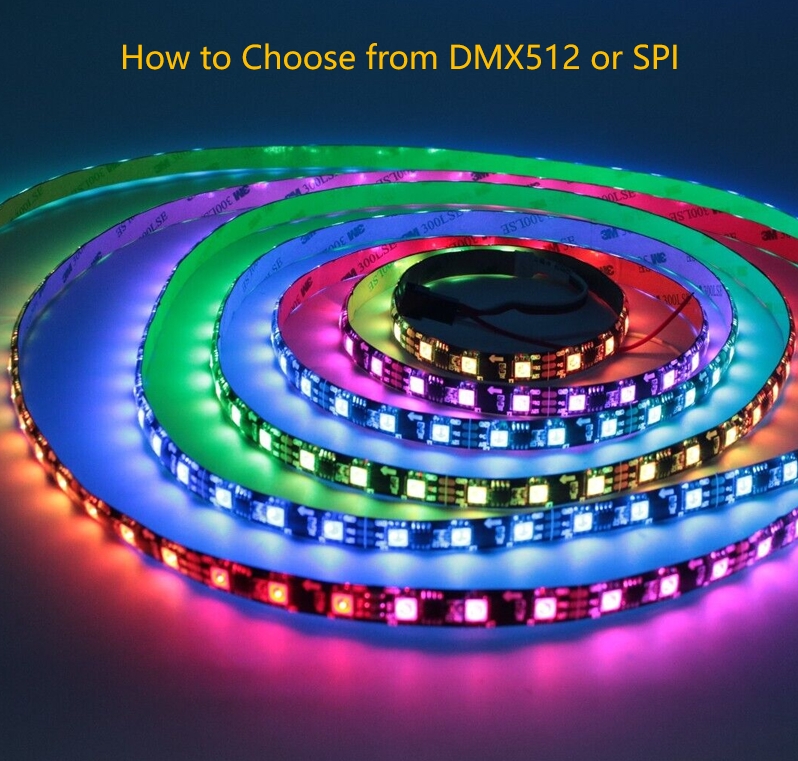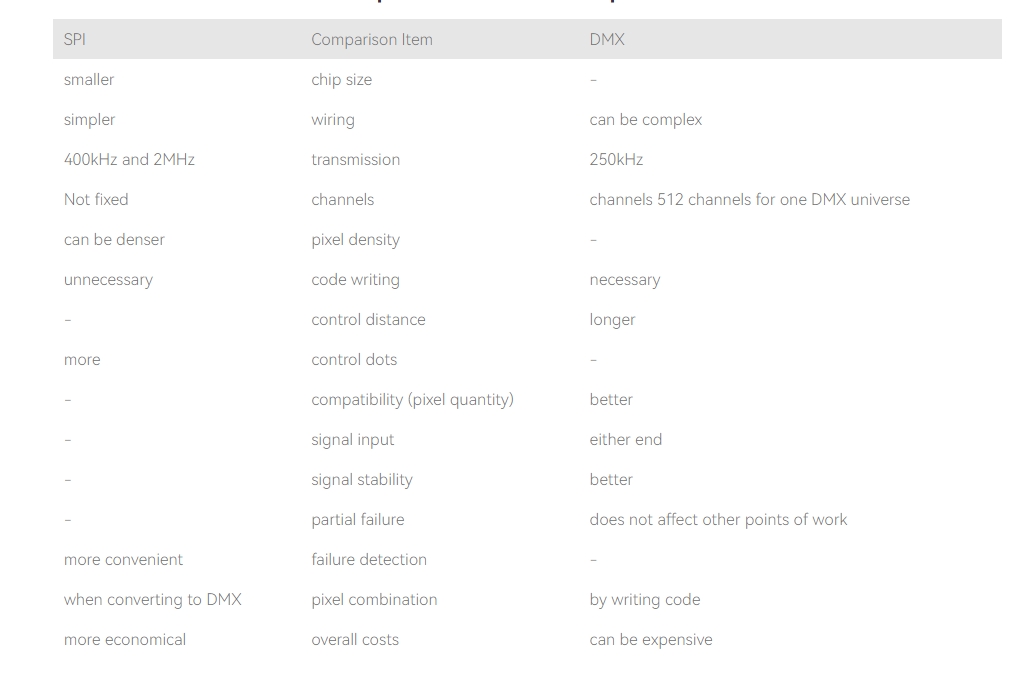Which is better: DMX LED Light Strip or SPI LED Light Strip 2023-04-06
DMX512 OR SPI

What is DMX512?
DMX512 is a standard for digital communication networks that are commonly used to control lighting and effects. DMX512 controller adopts 3-wire control mode to control DMX LED lights. For architectural lighting, large DC attenuation requires DMX repeater to be installed at a distance of 100m, and the control bus is set to parallel mode. Under the protocol, an address needs to be set for each light, and the address is generally set by a coder.
Under standard, the controller sends 512 data packets each time, and the chip assigns its own address according to the written code. The number of data packets intercepted by each chip depends on the number of designed channels, for example, RGB intercepts 3 data packets for the three channels of RGB, and RGBW intercepts 4 data packets for the four channels of RGBW.
Each packet consists of 11 bits, one of which is a start bit and two stop bits, and the other 8 bits are for the brightness of the channel that is divided into 256 levels from 0 to 100%. The control system can realize R, G, B, W each with 256 levels of gray scale, truly realizing full colors.
What is DMX512 used for?
It was originally intended as a standardized method for controlling stage lighting dimmers, which, prior to DMX512, had employed various incompatible proprietary protocols. It quickly became the primary method for linking controllers (such as a lighting console) to dimmers and special effects devices such as fog machines and intelligent lights.
DMX512 has also expanded to uses in non-theatrical interior and architectural lighting, at scales ranging from strings of Christmas lights to electronic billboards and stadium or arena concerts. It can now be used to control almost anything, reflecting its popularity in all types of venues.
What is SPI?
SPI stands for Serial Peripheral Interface and is a synchronous serial communication protocol. It allows you to transfer any kind of data. The SPI protocol is typically used to control addressable (or pixel) LED strips, because it enables transfer of more than 512 values. Typical SPI protocol used for addressable LED strips can control even 1000 individual RGB LED pixels.
SPI protocol is more suitable to control RGB LED pixels used in addressable LED strips. There is an issue though with SPI– there is no standard protocol to control pixel LEDs. You probably heard already about WS2811 or TM1914 LED strips. These are different SPI LEDs. That’s why you must set correct SPI protocol for your pixel LED strip you’ve purchased for your installation.
DMX-Controlled LED Strips VS SPI LED Strips

Conclusion
In conclusion, SPI and DMX-controlled LED light strips both can deliver dynamic lighting effects of all sorts. But when it comes to specific projects, lighting planners need to take a variety of factors into consideration before making the decision that fits the project best. For example, for a large project that requires long-distance transmission, DMX seems like the better option.
In the case of DMX, if a single light source fails to work, it doesn’t affect the rest; that’s not the case for SPI. In terms of budget, DMX lights usually cost more than SPI ones. Last but not least, the same importance should be attached to the expertise of lighting professionals on site. In light of time efficiency, on-site engineers are likely to go with the protocol they are most experienced with because spending extra time on training and getting familiar with something new is time-consuming and delays project delivery.
Yrlight Lighting offers a wide array of DMX and SPI LED flex lights and have numerous experience in delivering such projects across the world in entertainment, architectural, commercial, residential, light shows, etc.
Feel free to contact us if you want to learn more about our DMX Digital light series.